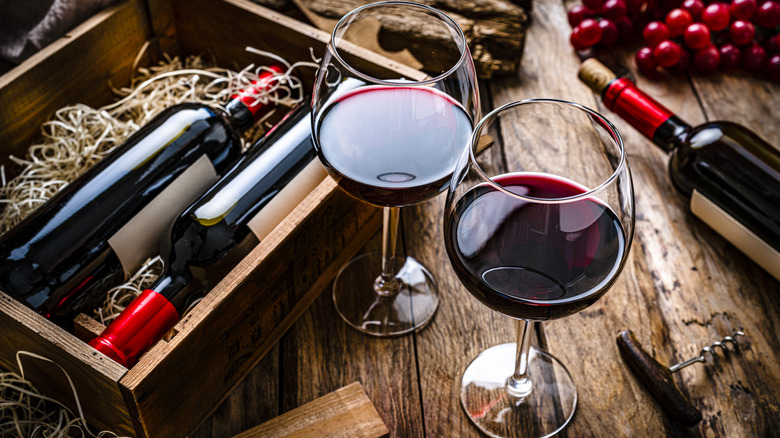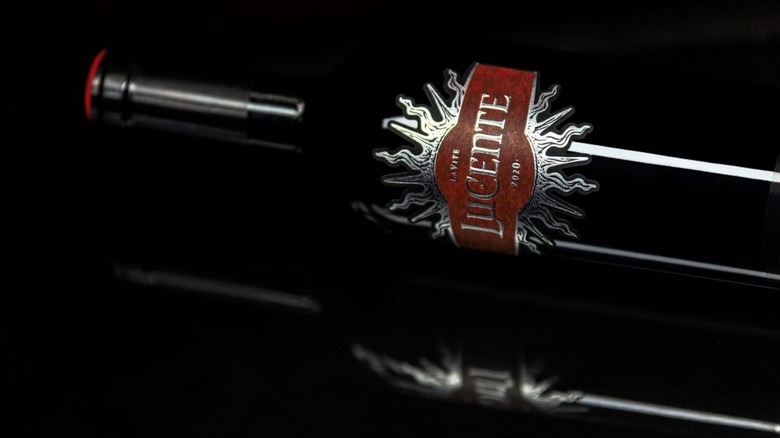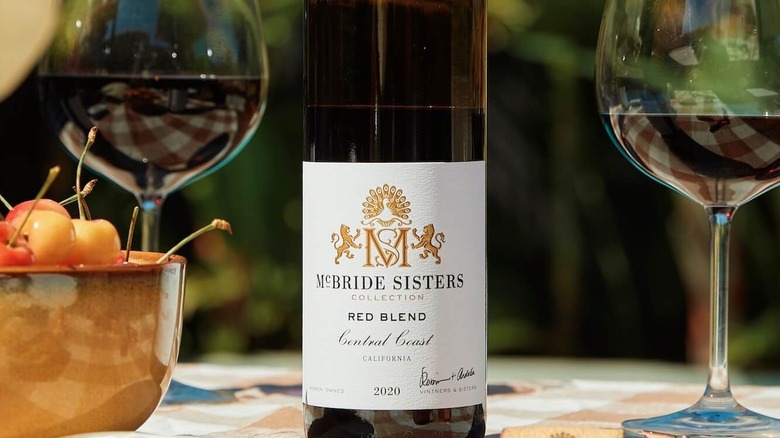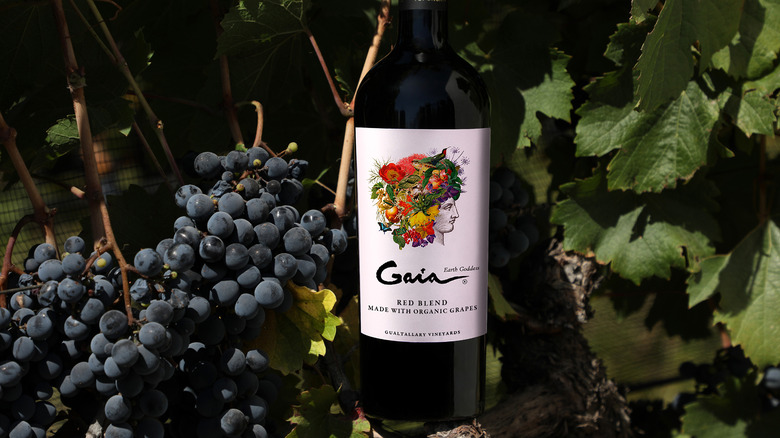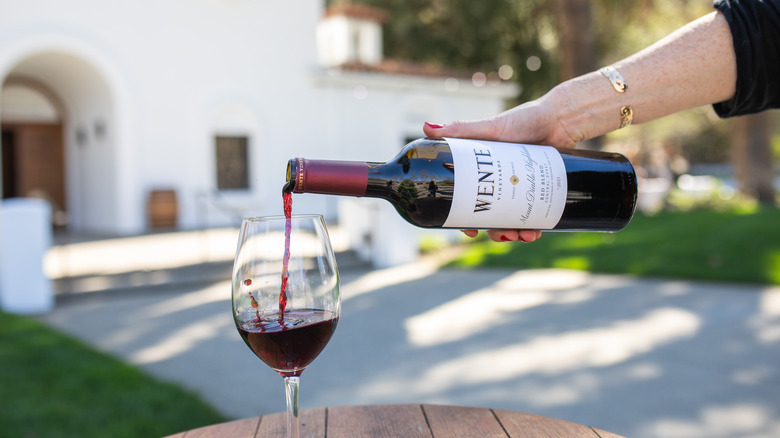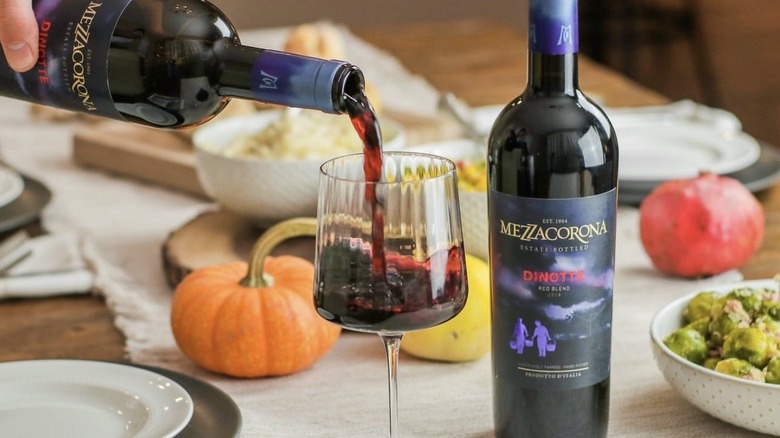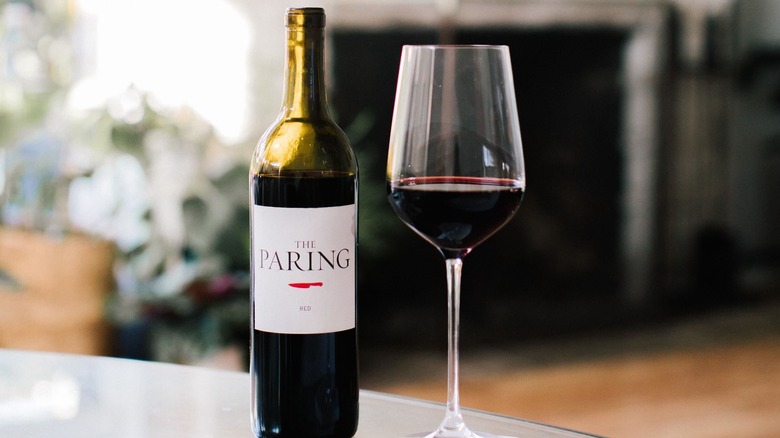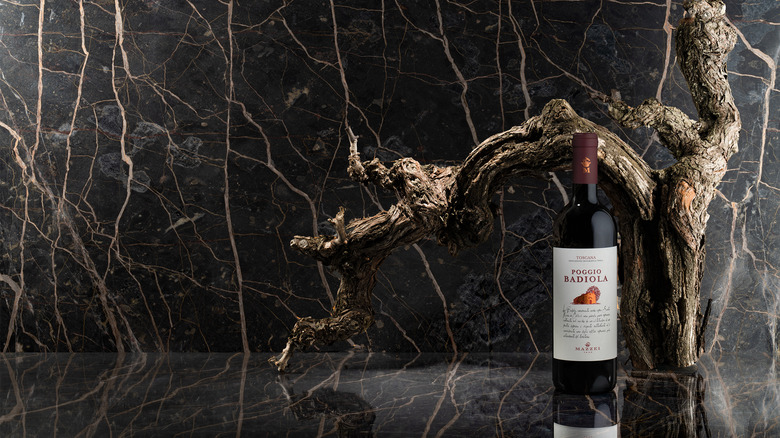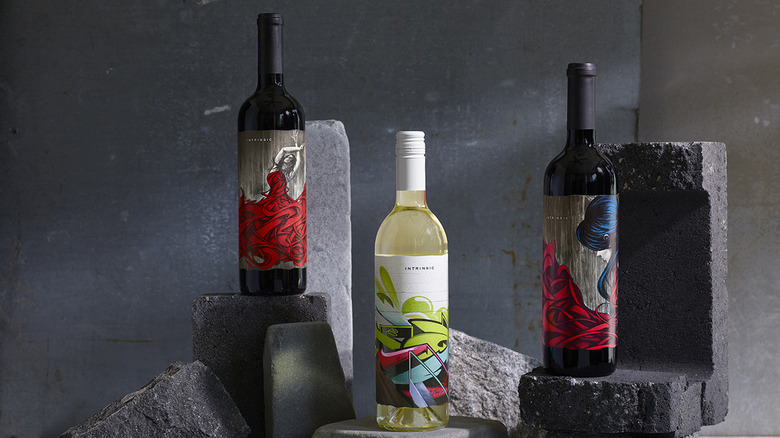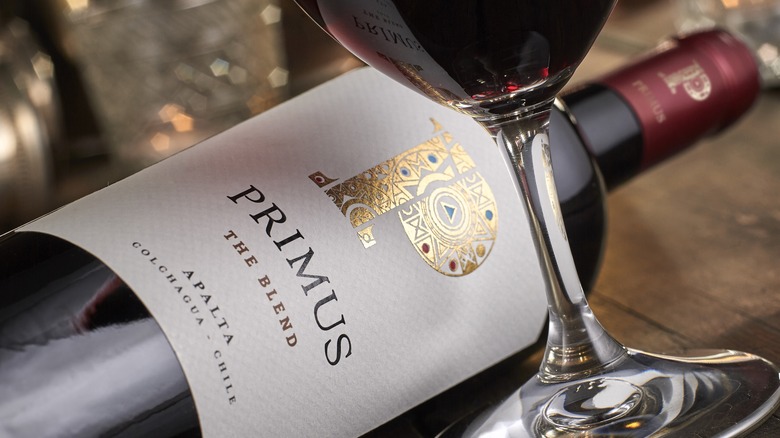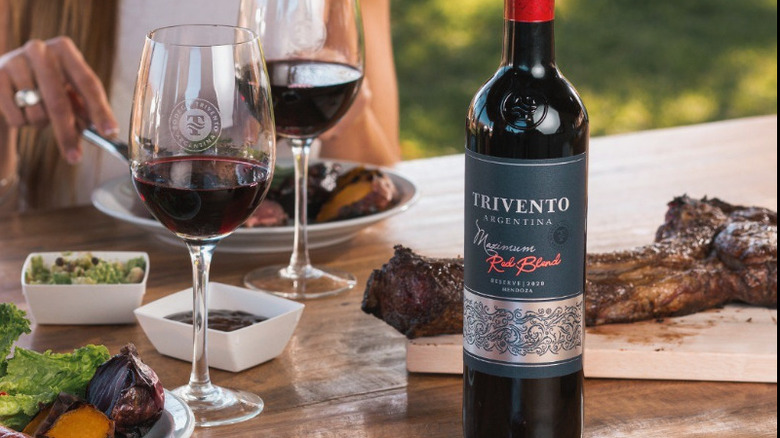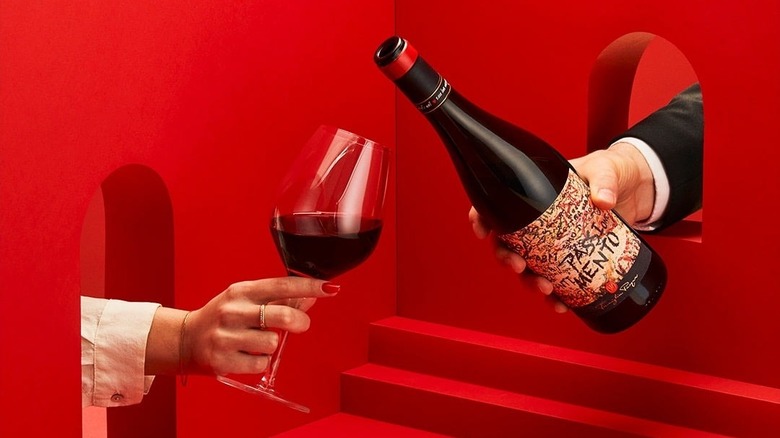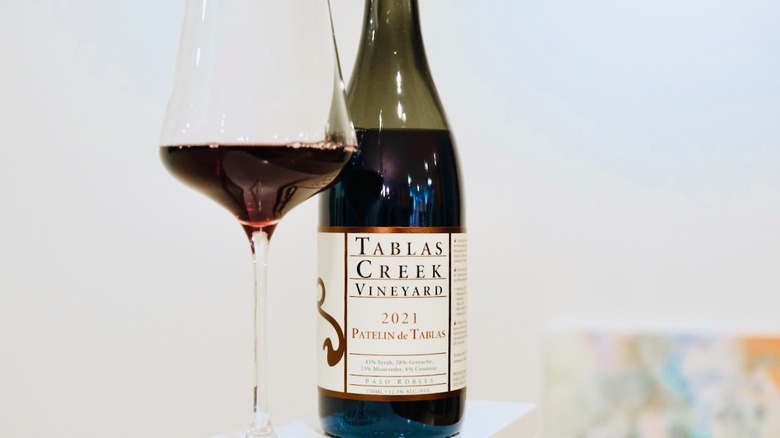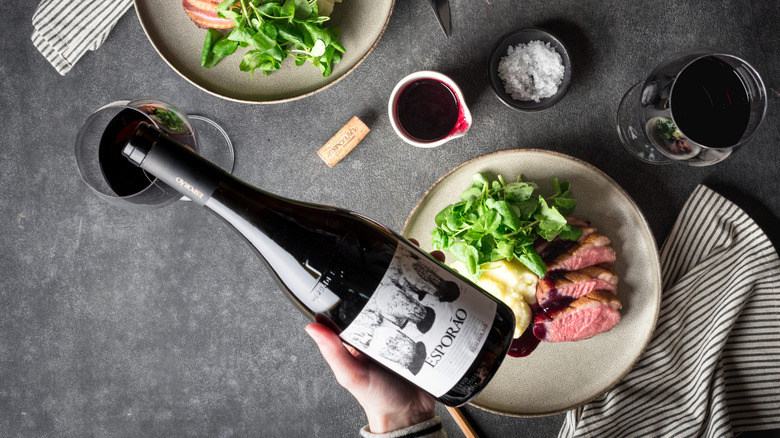The Best Red Wine Blends Under $30
One of the first things you learn when you start studying wine is that some of the most famous wines in the world are named for regions, not the grapes they are made from. You also learn that these wines are often blends rather than made from a single variety. For example, wines like Chianti, Bordeaux, and Rioja are so named for the region they come from and can be made from a mix of different grape varieties.
You also learn why winemakers choose to make blended wines to begin with. Historically, wines have been blended to increase quantities or provide insurance against issues that might hurt production, like drought, frost, vine disease and other weather-related threats to grape yields. Each grape variety possesses its own unique set of characteristics, from how it grows and ripens, to how it tolerates certain elements, to flavor and texture components like acid and tannin levels, color, and aromatics. Today, winemakers often approach blending with the attention of an artist, in which the whole wine is far greater — and more delicious — than the sum of its individual parts.
The red blend in particular has become a popular choice among wine lovers. These wines are typically easy-drinking and balanced, with each grape contributing an important element — like body, color, acid, tannin, aroma, and alcohol — to the final wine. In this round-up, we explore some of our favorites. The best part? These are all $30 and under.
Tenuta Luce Lucente
Tenuta Luce started as a joint venture in Montalcino, Italy, between California wine icon Robert Mondavi and Italian wine icon Vittorio Frescobaldi, and would later emerge as a symbol of modern winemaking in Tuscany. Lucente is a blend of 75% merlot and 25% sangiovese and represents what has come to be known as a "Super Tuscan" style of wine — typically (although not necessarily) a sangiovese-based blend made in a more modern, international style than the traditional Sangiovese-based wines of Chianti and Brunello di Montalcino. Lucente is the entry level selection from the estate, and the more value-driven sibling of the winery's celebrated flagship wine, Luce.
Here, merlot's weight, dark berry and plum fruit, and soft mouthfeel is given a lift by sangiovese's brightness, acid, and floral aromas. The result is an elegant yet full-bodied wine that, at $28.99, can equally play the role of everyday dinner wine and celebratory centerpiece selection.
McBride Sisters Collection Red Blend
Sisters Robin McBride and Andréa McBride John founded McBride Sisters Wine Company with an inspiring vision for the wine industry. Vowing to "lead by example and cultivate community, one delicious glass at a time," McBride Sisters is the largest black-owned and all women-founded wine company in the United States, with a portfolio of wine that spans coastal regions in California and New Zealand. They also boast a deep commitment to the environment, and became Certified Carbon Neutral in 2023.
On top of all of that, their wines are delicious and the McBride Sisters Collection Red Blend — produced from grapes sourced from California's Central Coast appellation—is no exception. For $18.99 a bottle, you get a soft and juicy red that's packed with ripe red and black fruit and a touch of spice and oak notes. It's easy-drinking but also contemplative, with a full mouthfeel and long finish thanks to silky tannins. This is the perfect backyard barbecue wine and would be a killer pairing for some smoky sweet beef short ribs.
Domaine Bousquet Gaia Organic Red Blend
Domaine Bouquet is a leader in organic and sustainable viticulture in Argentina's Gaultallary region in Mendoza. The Gaia Organic Red Blend is made up of 50% malbec, 45% syrah, and 5% cabernet sauvignon, a powerful combination of some pretty heavy-hitting grapes. And yet the wine still manages to maintain so much elegance thanks to a lift from mouth-watering acidity.
According to Greek mythology, Gaia is considered the personification of the Earth and perceived as the "mother goddess." Appropriately, Domaine Bousquet's Gaia line is made up of varietal wines like malbec, cabernet franc, and cabernet sauvignon, and different blends of estate-grown grapes, the percentages of which change from vintage to vintage to "reflect what Mother Nature has offered." All wines are produced entirely from organic grapes grown at a whopping 4,000 feet above sea level, conditions that yield intense flavors and juicy acidity to balance each wine. This wine, generally priced around $18 is one of my favorite sips tasted recently thanks to its generous fruit, judicious use of oak, and easy, approachable drinkability.
Wente Vineyards Mount Diablo Highlands Red Blend
If you've ever sipped a California chardonnay, there's a good chance it's tied to the Wente family, who planted the first chardonnay vines in California's Livermore Valley in 1908, ultimately grafting them in 1912 to vine cuttings brought in from France, thereby creating the famous "Wente Clone" of chardonnay.
But this round-up isn't about chardonnay! Thankfully this well-established certified sustainable vineyard and winery — the longest continuously family-owned and operated winery in the U.S. — produces a massive range of delicious wines, including their Mount Diablo Highlands Red Blend. This is a funky blend of 23% cabernet sauvignon, 19% petit verdot, 16% merlot, 11% equal parts barbera, tempranillo, and cabernet franc, and 9% malbec, all sourced from their Central Coast vineyards. It's medium-bodied, with bright red fruit and mocha notes from a kiss of oak, making it a versatile and food-friendly choice for a variety of occasions. The wine can be purchased nationally and on their website for $20.
Mezzacorona Dinotte Red Blend
Founded as a cooperative in the northern Italian region of Trentino in 1904, Mezzacorona is now one of the most recognized brands in Italian wine. Chances are, if you're one to order a glass of white wine while dining out, you've had the easy-drinking Mezzacorona Pinot Grigio at some point in your life.
In the Mezzacorona Dinotte Red Blend, two native grape varieties of the region — the deeply colored and perfumed teroldego and the tangy, slightly herbacious marzemino — bring floral aromatics, while merlot rounds the wine out with body and softness. This sustainably-farmed wine represents blending at its finest, bringing together diverse grapes that complement one another and each bring individual characteristics to the party to create one delicious and well-balanced wine. Pair this with any number of classic Italian dishes, or your favorite grilled meats and vegetables. At $15.99 a bottle, this is an absolute steal.
The Paring Red Blend
The name "The Paring" was inspired by the humble paring knife, cherished by chefs for its simplicity yet total versatility. Founded in 2006 by the team behind the prestige wines of JONATA and The Hilt Estate, The Paring wines are made from grapes sourced from the Santa Rita Hills, Santa Ynez Valley, and Santa Maria Valley appellations of California's Santa Barbara wine region. The range includes a crushable sauvignon blanc, a classic chardonnay and pinot noir, a smoky syrah, a bright rosé, and this crowd-pleasing red blend. All are well-made and produced to straddle the straightforward, easy-drinking category as well as the serious.
The Red Blend comprises 60% cabernet sauvignon, 19% cabernet franc, 14% merlot, 7% petit verdot in a true Bordeaux-style blend, aged in French oak for 22 months. Winemaker Matt Dees calls this wine "Balanced and refined, a study in elegance." The bottling has earned top 90+ scores from critics, including Jeb Dunnuck and Antonio Galloni and is a must-sip in my book, especially at $25 a bottle.
Mazzei Poggio Badiola Toscana
I have been in love with the wines of Mazzei since studying wine in Italy more than 15 years ago, which is admittedly a tiny drop in the bucket considering the Mazzei family has been producing wine in Italy since 1435. This not only makes them one of the most prolific and iconic families in Italian wine, but also among the longest running Italian companies of any kind. With estates throughout the country, including Tuscany in central Italy, the Maremma in coastal Italy, and Sicily in the south, Mazzei's entire portfolio encompasses the best of what this celebrated wine destination has to offer when it comes to delicious wines for all occasions.
I recall selling Mazzei's Poggio Badiola Toscana when I was the wine director and general manager of an independent wine shop in New York City many years ago. The wine's rich yet elegant flavor profile, complexity, and unmistakably Italian personality made it one of our best sellers and a great example of an approachable Super Tuscan style of wine. Today, I could sip this red blend by the case. It's a combination of 70% sangiovese rounded out by 30% merlot, both sourced from higher altitude vineyards in the Chianti Classico region of Tuscany, and an incredible value at around $17 a bottle.
Intrinsic Red Blend
If the brooding yet eye-catching label art doesn't compel you to snag a bottle of this wine, the wild spirit of winemaking that drives this brand should. Winemaker Juan Muñoz-Oca was raised in Argentina and brought up on winemaking under the tutelage and inspiration of his cellar master grandfather. Twenty-two vintages across 5 countries has driven Muñoz-Oca to marry time-tested winemaking techniques with an ongoing quest to innovate and push boundaries in his craft.
The result? A wine like the Intrinsic Red Blend. Made from a blend of cabernet sauvignon and malbec from Washington's Columbia Valley (with 50% from the esteemed Horse Heaven Hills AVA), this is a big, juicy red wine with a flavor profile as dark and brooding as the label suggests. Extended maceration — the process of leaving the juice on the grape skins to extract more texture, color, and flavor from the grapes — partial barrel fermentation, and concrete aging as well as time in oak give this wine its signature complexity and structure. Let's just say it's a lot of wine for around $24 a bottle.
Primus The Blend
Chile is always a reliable source for excellent value in wine. The country is bordered on each side by the Pacific Ocean and the Andes Mountains, with smaller coastal ranges and valleys throughout. This unique geographic location creates diverse growing conditions and provides natural protection from a variety of diseases and pests, including Phylloxera—the pest that wiped out a huge portion of the world's vineyards in the 19th century. The region is also heavily influenced by French winemaking thanks to early vine cuttings brought over by wealthy Chilean landowners, and French investors who saw the potential of the region thanks to its natural resistance to the Phylloxera that had destroyed so many of their vineyards.
As a result, Chile is known for wines made from classic Bordeaux grapes like cabernet sauvignon, merlot, and cabernet franc. Another signature grape of the region is carménère, which is a delicious alternative to cabernet sauvignon, but also a great partner for it. Primus was the first in Chile to blend this promising grape with cabernet sauvignon. Produced from organically and biodynamically-farmed grapes, The Blend primarily comprises Carménère and cabernet sauvignon, with small portions of syrah, petit verdot, and cabernet franc, and is Primus' flagship wine. Rich, robust, and packed with notes of dark berry fruit, chocolate, and baking spice, this wine is a stunning example of the quality of Chilean wine today. And, at around $18 a bottle, it is an affordable luxury for all occasions.
Trivento Maximum Red Blend Reserve
The Mendoza region of Argentina may be best known for malbec, but other Bordeaux varieties like cabernet sauvignon and merlot also thrive here. Mendoza is home to 76% of the country's vineyards and the greatest concentration of wineries in Argentina, which makes it a key player not only in the wines of Argentina, but also a global wine force. Trivento, named for three winds that influence the climate of the region, has been a leader in Mendoza since its inception in 1993, with their Reserve Malbec becoming the best-selling Argentinean wine in Europe in 2013.
The Maximum Red Blend — a 50-50 blend of malbec and cabernet sauvignon — is named after Trivento Winemaker Maximiliano 'Maxi' Ortiz. For around $11 a bottle, the blend is an ultra-friendly, straightforward wine that's got tons of blackcurrant and raspberry compote laced with black licorice and cinnamon and a touch of black pepper. If you've ever been invited to enjoy a traditional Argentinean Asado — the classic gathering featuring a smorgasbord of mixed grilled meats, salads, and sauces — you'll know that this is the exact style of wine served alongside this type of rustic fare.
Pasqua Romeo and Juliet Passimento Rosso
Founded in 1925, Pasqua Vigneti e Cantine boasts nearly a century of winemaking heritage in the Veneto region of Italy. In 2023, Pasqua was named "Innovator of the Year" by Wine Enthusiast Magazine in recognition of its commitment to fostering change, creativity, sustainability, and leadership in the wine industry.
The Pasqua Romeo & Juliet Passimento Rosso is a delicious blend of equal parts of two native Italian grapes corvina and croatina blended with 40% of Merlot. In the traditional appassimento process, grapes are picked by hand and dried naturally in wooden crates, which reduces the water content of the grapes and intensifies their sugars, aromas and flavors. When the grapes are then fermented, the resulting wine is deeply concentrated, flavorful, and often slightly higher in alcohol. The partially dried grapes for Romeo & Juliet Passimento Rosso are vinified in steel tanks and then blended and aged in large oak barrels for six months, which adds complexity and texture to the wine without overwhelming it with oak flavors. The result is a rich, velvety wine with prominent fruit along with some exotic spice and mocha notes and a gorgeous, layered finish. This is an incredible wine for under $20, let alone under $30.
Tablas Creek Vineyard Patelin de Tablas
Located in California's Paso Robles region, Tablas Creek Vineyard is largely credited with establishing the region as a powerhouse for Rhône-style blends. The winery is a joint venture between the Perrin family of the famed Château de Beaucastel in France's prestigious Châteauneuf-du-Pape appellation and Robert Haas, American wine importer and founder of Vineyard Brands. In other words, some impressive pedigree fuels this cult-status winery.
The Tablas Creek Patelin de Tablas is a top-rated California Rhône-style blend made up of 54% syrah, 29% grenache, 13% mourvèdre, and a touch of counoise and terret noir. It's a classic mix that brings the best of what each grape has to offer — syrah for dark, peppery fruit, grenache for freshness and lift, mourvèdre for weight and structure, and the rest for complexity and that certain je-ne-sais-quoi that makes this wine so compelling. This is a supremely drinkable wine, with tons of juicy fruit and just the right amount of earthiness and spice. For $28, snag a bottle or three of this top-scoring wine quickly as the wines of Tablas Creek regularly sell out. This one also comes in a 3-liter box to please a crowd.
Esporão Reserva Red
One of my favorite regions to turn to for reasonably priced, delicious, and totally interesting wines is Portugal. There are plenty of reasons so many seem to be taking to Instagram and posting photos of themselves vacationing in this exciting European destination, including the amazing wine scene. The infinite number of tough-to-pronounce native grapes of the region may be daunting to learn, but this shouldn't stop you from exploring some of the unique table wines that Portugal produces.
The Esporão Reserva was the first wine Esporão produced back in 1985. It comes from the up-and-coming region of Alentejo in Southern Portugal, and is a blend of mostly alicante nouschet, touriga nacional, aragoez, trincadeira, and cabernet sauvignon aged for a year in French and American oak. It's a medium-bodied wine with mouth-watering red and purple berry fruit, plum, cedar box, chocolate, and baking spice. This is a total food wine that sings when paired with some of the classic local Portuguese dishes you'll want to sample when, inspired by those social media feeds, you inevitably hop on a plane to visit the region in person.
